BY ABBY AGUIRRE,
ON a rainy afternoon in March, dozens of tween girls filed into an auditorium at New York’s Lower Eastside Girls Club. They were there to hear Simone Biles talk about beauty standards. She arrived fresh off a plane from Indianapolis, where she had spent the morning training, and the room went bananas when she walked in, a four-foot-eight powerhouse in a color-block turtleneck and blue jeans. She sat on a couch at the front of the room. Her feet, in pearly ankle boots with Lucite heels, barely touched the floor.
Biles delivered her remarks in the dutiful and direct way that athletes and coaches give interviews. She loves gymnastics, she said, but not the beauty competition that comes with it: “No matter how good you are in your sport, in life, in work, the number one thing people talk about is how you look.” She urged the girls to handle such pressure by ignoring it. “You’re still going to thrive. You’re going to become somebody amazing and great. You guys are all beautiful, inside and out.” Whoops and cheers all around.
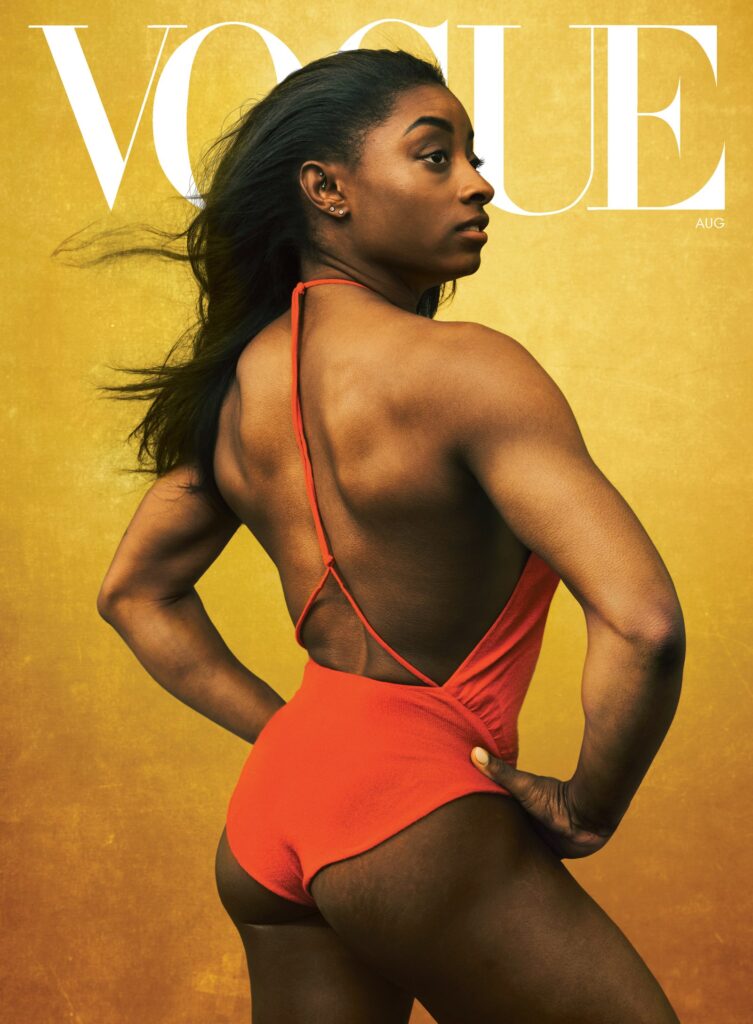
Photographed by Annie Leibovitz, Vogue, August 2020
This was, of course, early March, which is to say a million years ago—before the coronavirus pandemic all but shut down New York City, before the Olympics were post-poned, before it was clear that nobody should be in a confined space with a crowd. The Lower East Side talk was the first of several appearances Biles was making on behalf of the Japanese skin-care brand SK-II. She and a few other Olympians—including the table-tennis player Ishikawa Kasumi, the badminton duo Ayaka Takahashi and Misaki Matsutomo, and the surfer Mahina Maeda—are the faces of an ad campaign that proclaims beauty should be “no competition.”
SK-II is a sponsor of the Tokyo games—which, as of this writing, have been postponed until July 2021, unless they are moved again or canceled altogether—but that isn’t the only reason Biles signed on. She is deliberate about her endorsements. She works with Mattress Firm because the company donates mattresses, pajamas, and bedtime books to foster kids. (Biles spent time in foster care.) The #NoCompetition campaign is similarly personal for Biles, who has faced demeaning and repulsive attacks about her body from spectators, competitors, and relentless online trolls.
It was time for questions. A short girl in a blue sweatshirt that said GOD IS DOPE wanted to know if Biles received rude comments when she began competing. Yes, Biles said: “They focused on my hair. They focused on how big my legs were. But God made me this way, and I feel like if I didn’t have these legs or these calves, I wouldn’t be able to tumble as high as I can and have all of these moves named after me.” A tall girl with red braids asked Biles how she felt about being a Black gymnast.
Biles nodded. “Growing up, I didn’t see very many Black gymnasts,” she said. “So whenever I did, I felt really inspired to go out there and want to be as good as them. I remember watching Gabby Douglas win the 2012 Olympics, and I was like, If she can do it, I can do it.”
Hands flew up. How many medals did Biles have? “I should probably memorize this answer, but it keeps changing,” Biles said. “The most!” someone called out. “Yeah, I do have the most,” Biles said. “I think it’s at 25, but I’m not really sure. I would have to google it.” (She has 30.) A girl in the back wanted to know how many injuries Biles had gotten. “I’ve been very fortunate in my career that I haven’t had too many injuries,” Biles said—just bone spurs, a broken rib, toes shattered and cracked. The girls gasped.
Another asked, “Do you think you’re obligated to stand up when something bad is going on in society?” The question summoned the specter of Larry Nassar, the longtime USA Gymnastics doctor who is now serving a sentence of up to 175 years for the sexual abuse of athletes, including Biles. For two years and counting, she has been trying to hold officials in her sport accountable. “Personally, for me, I don’t think of it as an obligation,” Biles said. “I think of it as an honor to speak for the less fortunate and for the voiceless. I also feel like it gives them power.”
Biles posed for a group photo. Then she and her small entourage got into black SUVs and headed for Times Square. Biles rode with her mother, Nellie, a petite woman with a no-nonsense manner and kind eyes. I rode with a team from SK-II. As we flew up FDR Drive, word arrived that, because of the rain, Biles would not be doing a split leap at the event. (No risking injury.) The group reconvened in a hotel lobby and proceeded to Broadway and Seventh Avenue. Biles, now wearing gray leggings and a cream puffer coat, stood on a platform, enveloped by a growing crowd. She said a few words, and then an anime film began to play on enormous digital billboards. In it, a small cartoon Biles faced off with a 200-foot-tall monster whose blobby body was composed of comments made about her on social media. As Biles confronted the towering troll, the comments flashed across the frame: “Her calves errrrhmygod.”
The rain died down to a drizzle, and Biles started giving short interviews to a succession of news crews. Between them, she obliged crowd requests for high fives, and every time she did, a tall blonde woman (her agent, Janey Miller, it turned out) doused Biles’s hands in Purell. A fire truck pulled over, and six firefighters got out—to get a photo with Biles. Along the Broadway side of the plaza, a young gymnast pressed against a crowd barrier. She held up a handwritten sign:
I LOVE Simone!!
(Level 3, Jr A)
watch me KIP!!!
The reference to kipping—a swinging pull-up on the uneven bars—worked like a smoke signal. Nellie walked over, got the sign, and ferried it to Simone for autographing. As the girl waited patiently in the drizzle, I asked her why she loved Biles so much. Her gaze remained fixed on Biles when she responded, “Because she’s the strongest.”
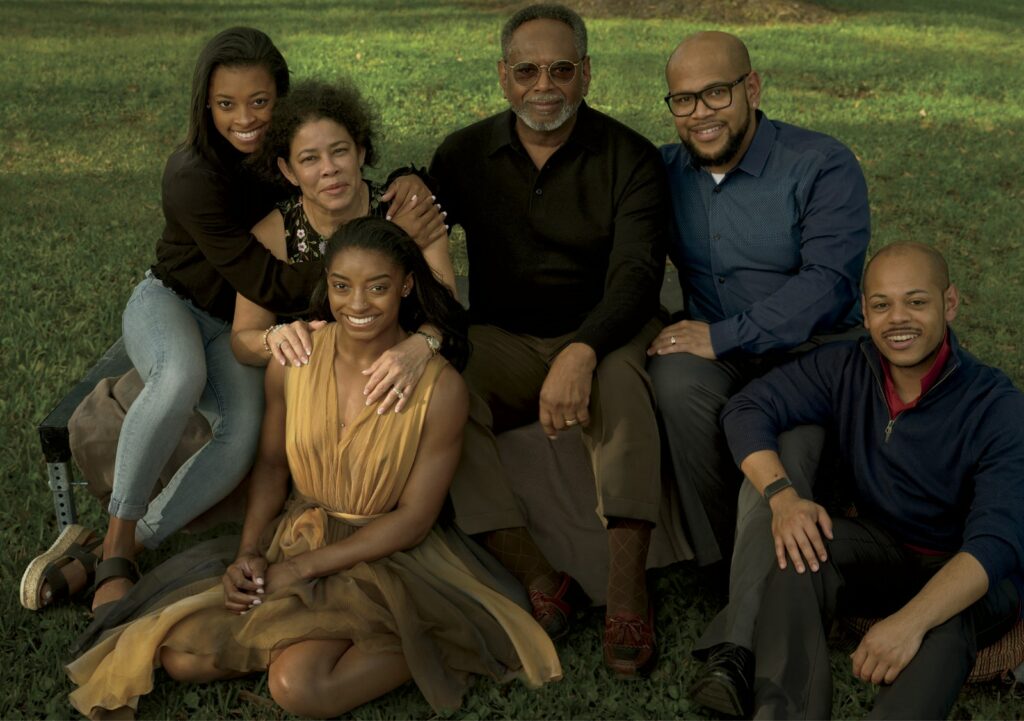
Photographed by Annie Leibovitz, Vogue, August 2020
SIMONE BILES is the strongest gymnast—the greatest of all time, male or female, and this is no longer a matter of opinion. In the individual all-around category, Biles hasn’t lost a meet since 2013. As of October, when she won her fifth all-around international title, Biles became the most decorated gymnast in World Championship history.
But the statistics, rankings, and records obliterated don’t fully capture how she dominates her sport. Her tumbling passes in particular seem to involve trompe l’oeil. Wearing an expression of stoic certainty, eyelids at half-mast and ponytail bobbing, she barrels into a force-gathering series of roundoffs and handsprings, then explodes into the air as if an invisible hand has pressed an eject button. Biles appears to have a different relationship with gravity; she seems to bend both space and time.
From the start, Biles was poised to maximize the possibilities of a new scoring system in gymnastics, first adopted in 2006, when she was nine. Where gymnasts once aspired to a perfect 10, they now earn two scores—one each for difficulty and execution. The second is capped at 10, but the first is limitless. Try a harder maneuver in competition and you can get a higher maximum score. Biles has made a career of that.
Her triumph at Rio 2016 came with a dash of swagger. “I’m not the next Usain Bolt or Michael Phelps,” she said. “I’m the first Simone Biles”
Going into the 2016 Olympics in Rio, Biles, then 19, was already in rarefied air. Some teammates admitted that they were all competing for second place. Even Biles seemed astounded. “I kind of blow my own mind,” she told one reporter. She won four gold medals that summer, the first female American gymnast to do so at a single Olympics, and one bronze. She did it with a smile, as is the norm in her sport, but also with a dash of swagger. “I’m not the next Usain Bolt or Michael Phelps,” she said. “I’m the first Simone Biles.”
Female gymnasts typically peak as teenagers. And yet, when Biles returned to competition after Rio, at 21, she won national and international titles with almost workaday consistency. When Biles introduced a dangerous new skill on the competition circuit last fall—a “double–double” beam dismount, involving two flips and two twists—the International Federation of Gymnasts gave it a lower difficulty value than expected, in part to dissuade other gymnasts from trying it.
Comparisons with athletes may irritate Biles, but they are unavoidable, since gymnastics—whose punishing rigor is cloaked in glitter and sequins—requires some translation. She is often likened to living legends like Bolt, Phelps, Serena Williams, Tiger Woods. But a more apt reference may be Wilt Chamberlain, the imposing NBA center and statistical phenomenon who was so tall, so fast, and so sensationally good, the sport of basketball preemptively outlawed his mythical foul-line dunks.
In recent years, Biles’s rise has taken place against a horrific backdrop. The revelation that Larry Nassar sexually abused hundreds of gymnasts, including all five members of the 2012 Olympic team and four of the five members of the 2016 team, was the first horror. Then it became clear that Nassar had enablers—at Michigan State, where he was on faculty, but also at USA Gymnastics and the U.S. Olympic and Paralympic Committee. Amid the fallout, Biles emerged as a powerful check on her sport’s governing body. She is the only Olympic gymnast who disclosed abuse by Nassar and continued competing at the elite level. Her willingness to speak out from within the sport has made her an even bigger hero and invited yet more comparisons to iconic athletes with iron moral codes, like Muhammad Ali, though even this parallel is inexact. Sexual abuse inflicts a uniquely isolating mix of stigma and shame.
And that’s what this story was supposed to have been about: an athlete of unprecedented dominance returning to the Olympics, where to compete at all she has to represent the very organizations that wronged her, and which she has spent the last two years staring down. But then something even more unprecedented happened. The Olympics—well, they disappeared. Overnight, years of carefully laid plans were thrown into limbo.
In the unforgiving timeline of an elite gymnastics career, a year’s delay is an eternity—especially for an athlete four months away from retiring, as Biles was when I first met her in New York. At 23, Biles is already unusually old for an Olympian. Next summer, she will be 24. The road to 2021 will require another year of punishing training and avoiding injury, if there is such a road at all.
BILES’S SOVEREIGNTY seems almost inevitable now, as an old-world sport long dominated by bouncing pixies has evolved to reward innovation. But none of it was inevitable. When she was born—in 1997 in Columbus, Ohio—her biological mother was struggling with drugs. Her biological father was out of the picture. Biles was three when child-protective services placed her and her three siblings in foster care. Their foster parents, Miss Doris and Mr. Leo, had a beagle named Teddy and a trampoline that Biles was not allowed to jump on. Instead, she would play on a swing set in the backyard. Imitating her older brother, Tevin, Biles would swing high and then dismount midair by doing a backflip.
Eventually, the four kids—Biles, Tevin, her older sister, Ashley, and her younger sister, Adria—went to stay with their maternal grandfather, Ron, a retired Air Force sergeant who worked as an air-traffic controller, and his second wife, Nellie, a regional nurse who had emigrated from Belize. (When Biles was born, it was Ron who had suggested the name Simone, she writes in her 2016 memoir, Courage to Soar: “He’d liked the sound of it ever since he was a teenager listening to Nina Simone records in the housing projects in Cleveland.”) Ron and Nellie lived in Spring, a suburb north of Houston. They had two sons of their own—Ron II, who was 16, and Adam, 14. They also had a trampoline, and this time, Biles was allowed to jump on it.
Biles and Adria formed an attachment to Nellie. In her memoir, Biles affectionately recalls how, on her first day in Spring, Nellie wedged Biles between her knees and redid her hair, washing and combing and brushing and braiding: “I loved the feel of my grandma’s hands in my hair. I loved the look of concentration on her face as she worked.” After a failed reunion with their mother and another stint with Miss Doris and Mr. Leo, Simone and Adria were officially adopted by Ron and Nellie in 2003. (Tevin and Ashley were adopted by Ron’s sister, Aunt Harriet, in Cleveland.) Grandma and Grandpa became Mom and Dad.
Biles has extraordinary air awareness, a knack for knowing where your body is in space as you flip and twist. This is more innate sense than acquirable skill
A media consensus seems to have formed that 2018 was the year Biles “found her voice,” but Courage to Soarsuggests she always had one. Self–assertion is a prevailing theme throughout. Biles describes her three-year-old self as “just plain stubborn” and a “bossy little thing” who lorded it over her younger sister.
Biles was also remarkably physical. During the girls’ first stay in Spring, Nellie would often enter their room in the morning to find Biles sleeping in Adria’s crib. Nellie assumed Ashley was letting down the side of the crib at night, until one day she walked in and saw Biles hoisting herself up, one leg slung over the rail. Later, Biles made it a habit to roll out of bed in the morning, grab her overalls, and head straight to the trampoline. Ron II and Adam would double-bounce Biles to see how many times she could flip before she landed. Another favorite game was to see how many pull-ups she could do on their outstretched arms. When Biles was six, Nellie enrolled her in classes at a local gym. She spent only a few days in recreational before she was transferred to team.
Biles was already muscular. (By the third grade, boys at school had taken to calling her “swoldier,” a portmanteau of “swollen” and “soldier.”) She also had extraordinary air awareness, a knack for knowing where your body is in space as you flip and twist in flight. This is more innate sense than acquirable skill—it can be practiced but not taught. But Biles did not always advance at warp speed. She sometimes fell in competition and was occasionally uninterested in doing the tedious work of perfecting her routines. Her longtime coach, Aimee Boorman, didn’t push her to conform. Boorman had coached Biles since she was eight and understood her temperament: She wouldn’t do anything she didn’t want to do. It had to be fun, or Biles would quit. Together they had a mantra: It’s just gymnastics.
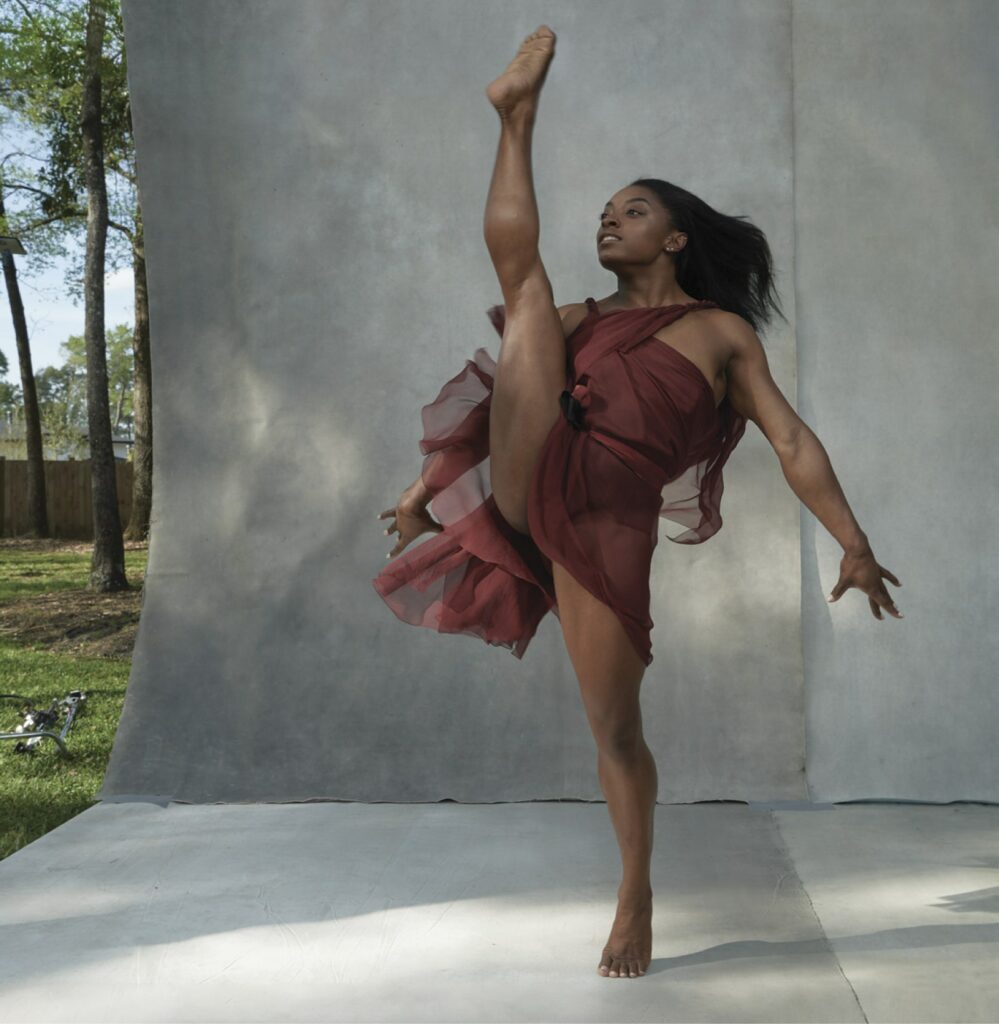
Photographed by Annie Leibovitz, Vogue, August 2020
Boorman’s approach kept Biles in the sport. It also set her up for a rude awakening in elite gymnastics. When Biles was 14, she was invited to a developmental camp at the Karolyi Ranch, the former national-team training center run by Bela and Martha Karolyi, the stone-faced rulers of American gymnastics. “The ranch,” as it was known, occupied a 2,000-acre compound inside Sam Houston National Forest, about 60 miles north of Houston. Biles was expecting campfires and marshmallows. Instead, she was in the gym from 8 a.m. to 7 p.m., breaking skills down to their elements. The sessions were grueling, the repetition relentless.
The formality and rigidity did not suit her. But as Biles progressed, making the junior national team, she had to adapt. There was only one road to the Olympics, and the Karolyis were it. Every gymnast knew that the Karolyis had trained both Nadia Comaneci and Mary Lou Retton. It was Bela who had pushed Kerri Strug to perform her second vault at the 1996 Olympics with a broken ankle, clinching the first-ever team gold for the U.S. in women’s gymnastics, and it was Bela who carried Strug to the podium to accept her medal. Biles learned quiet obedience, or at least the appearance of it. “Being committed meant you kept a straight face,” she writes.
Biles did not keep a straight face at home. Within the family, the stretch of time between the fall of 2011 and the summer of 2013 is still known as Simone’s Bratty Period. There was a lot of talking back, mumbling under her breath, frequent temper tantrums. Part of it was the usual teenage stuff. But the brattiness was also converging with new levels of sacrifice. Biles had already been putting in 25 to 30 hours of training a week. She had to get to 35. To make up the difference, she started homeschooling.
“Not that I wanted to make it a living hell for myself, but I wanted to make it as hard as possible, not just on me but on everybody,” Biles told me. “I didn’t know how to handle it, so I just lashed out at everybody. Like it was everybody’s fault but mine.” It’s hard to pinpoint why the Bratty Period ended when it did. Biles started seeing a sports psychologist that summer, which helped. She also started winning.
Biles first took individual gold at the 2013 National Championships. Since then she has been untouchable. At the World Championships that year, where she also took gold, Biles landed a new trick on the floor—a double flip in a straight body position with a half turn at the end. Because she was the first to perform it in an international competition, the skill was named “the Biles” in the Code of Points. (There are now three more skills named after her.) The story of Biles’s first international win immediately became a story about racism when an Italian gymnast, Carlotta Ferlito, told reporters, “Next time we should paint our skin black, so we could win, too.” (Ron, reached by a reporter, responded: “Normally it’s not in Simone’s favor being Black, at least not in the world that I live in.”) By November 2015, Biles held the most gold medals of any female American gymnast in history. To mark the occasion, she posted to Instagram a photo of herself with 14 world medals draped around her neck and the caption “Work hard in silence let your success be the noise.” After her five-medal haul at the Rio Olympics, Team USA voted for Biles to carry the American flag in the closing ceremony.
Biles has fought for an independent investigation of her sport’s handling of the Nassar case: “We need to figure out why it happened, when it happened, and who knew what, when”
THE LARRY NASSAR story broke three weeks after the closing ceremony in Rio. The first piece was published by the Indianapolis Star—two former gymnasts, one an Olympic medalist, were accusing Nassar of sexual abuse.
Over the following year and a half, the scope of Nassar’s crimes came to light: The longtime team physician for USAG was possibly the worst predator in the history of American sports. But when the Star story came out, many gymnasts, Biles included, had not yet processed what had happened to them. Biles was a new superstar, traveling the United States on a post-Olympic tour.
At that point, it had been a year since Nassar had anything to do with USA Gymnastics. He had been quietly let go as team doctor in 2015, after a coach overheard gymnasts talking about his treatments and reported her concerns to USAG. The organization conducted an internal investigation, then referred the matter to the F.B.I. in Indianapolis. But nobody from USAG told Biles or Nellie. “He had left because he was ill or something like that,” Nellie recalled.
The story left Biles in a disjointed mental and emotional state. “It didn’t feel like real life,” she told me of this period. “And there were little things that I did that I didn’t know why, but I felt like I was just trying to protect myself.” Such as? “Just, like, little quirks. Like I remember on tour, I would have really bad anxiety about nothing. Or like, walking down a hall, I feared that somebody was following me. I just had a lot of issues that were unexplained until I finally figured out why. The dots connected.”
After the tour, Biles competed on Dancing With the Stars. But the drip-drip-drip of developments in the Nassar story continued. Nassar was arrested on child-pornography charges in late 2016. In February, three former Team USA gymnasts went on 60 Minutes and described the abuse Nassar had inflicted on them, how he had passed it off as legitimate medical care. The following month, the president of USA Gymnastics, Steve Penny, resigned.
Inside her family, Biles effectively declared the topic off-limits. “Whenever my parents would ask me about it, or my brothers, I would just shut it down,” Biles said. “Like, No! It didn’t happen! I would get really angry.” Nellie tried to broach the subject. “I asked several times,” she said. “Her reaction was awful. Scream and walk out the door and not want to discuss it.” Did the strong reaction worry Nellie? “Of course it did,” Nellie said. “When somebody responds like that. . . .”
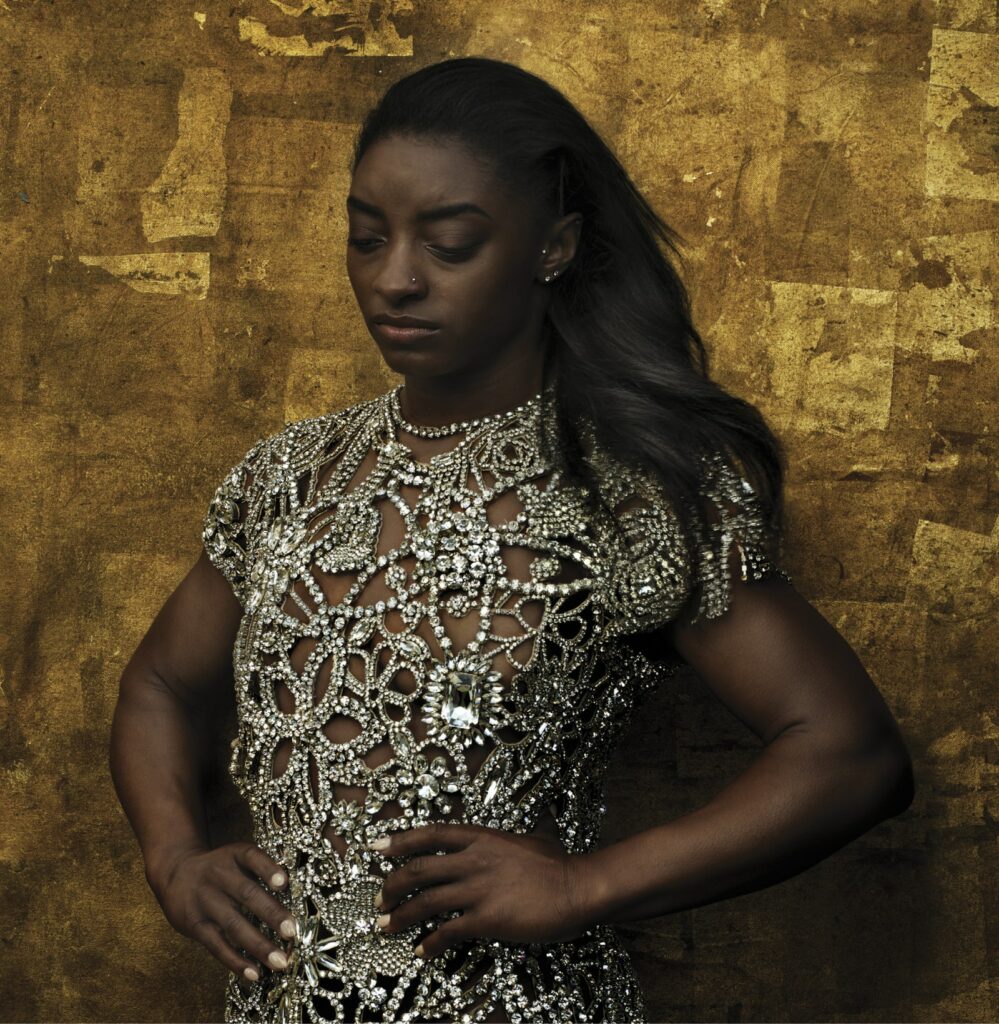
That summer, Biles moved out of Ron and Nellie’s house and into a condo of her own—the beginning of an “adulting” process, she told me. For a while she could do little more than sleep. “I was very depressed,” Biles said. “At one point I slept so much because, for me, it was the closest thing to death without harming myself. It was an escape from all of my thoughts, from the world, from what I was dealing with. It was a really dark time.”
Biles has never described the abuse, and I didn’t press her to. As national medical coordinator for USA Gymnastics, Nassar was present at all major competitions and at monthly training camps at the Karolyi Ranch. This means Biles was likely required to see him from the time she joined the junior national team in 2012, when she was 15, if not before, until his departure in 2015.
Biles ultimately reckoned with her own abuse in early January 2018, after a friend and former member of the national team, Maggie Nichols, told her story to the press. Until that moment, Biles had not considered her experience to be abuse, in part because she thought it wasn’t as bad as what others had gone through. “But I was reading Maggie’s coverage and it just hit me,” Biles said. “I was like, I’ve had the same treatments. I remember googling, like, sexually abused. Because I know some girls had it worse than me. I know that for a fact. So I felt like I wasn’t abused, because it wasn’t to the same extent as the other girls. Some of my friends had it really, really bad. They were his favorite. Since mine wasn’t to that capacity, I felt like it didn’t happen.”
In retrospect, Biles said, there may have been another reason for the mental block: “I felt like I knew, I just didn’t want to admit it to myself, that it had happened. Because I felt like, not that you’re supposed to be perfect, but I just felt like that’s what America wanted me to be—was perfect. Because every time an American wins the Olympics, you’re like America’s sweetheart. So it’s like, How could this happen to America’s sweetheart? That’s how I felt—like I was letting other people down by this.”
Biles posted a statement to Twitter and Instagram on January 15, 2018—one day before survivors of Nassar’s abuse were to give victim-impact statements in a Michigan courtroom. “Most of you know me as a happy, giggly, and energetic girl,” she began. “But lately I’ve felt a bit broken and the more I try to shut off the voice in my head the louder it screams.” Biles, too, had been sexually abused by Larry Nassar: “Please believe me when I say it was a lot harder to first speak those words out loud than it is now to put them on paper.” She added, “It is impossibly difficult to relive these experiences, and it breaks my heart even more to think that as I work toward my dream of competing in Tokyo 2020, I will have to continually return to the same training facility where I was abused.”
“We need justice,” Biles said of the protests sweeping the country in June. “It’s sad that it took all of this for people to listen”
Biles did not attend the sentencing hearing. Still, coming forward was cathartic. “For me, it was a weight that I carried so heavily on my chest, so I felt like, if I shared it with people, then it would be a relief for me,” Biles told me. “And I knew that by sharing my story, I would help other survivors feel comfortable and safe in coming forward.”
Initially, 88 women had signed up to speak at Nassar’s sentencing hearing. As the first day of harrowing impact statements streamed live on the internet, that number began to grow, fueled by the #MeToo movement. By the end of January, all members of the USAG board of directors had resigned, along with the president of Michigan State. In February, the head of the U.S. Olympic Committee, Scott Blackmun, resigned too.
The online gymnastics community, called the Gymternet, seized on an additional development. Four days after Biles posted her statement, USAG severed ties with the Karolyi Ranch. Effective immediately, the ranch—national training center since 2001, Olympic training site since 2011, synonymous with USAG for two decades—was no longer a stepping-stone for gymnasts with Olympic dreams. (“Ding Dong the Ranch Is Dead,” declared the popular podcast GymCastic.) Others had called for the ranch to be shuttered, which only made it clearer that Biles’s post was the catalyst—“the tweet that closed the ranch,” as the Olympic Channel put it. Biles was startled by the sway she had. “I was really shook,” she recalled.
Biles returned to competition in July of that year, and while the big headlines focused on the extraordinariness of her comeback, a subplot was developing. Every time she weighed in with an opinion about what needed to happen in gymnastics, it would happen. Immediately.
When Biles expressed dismay that the new head of USAG, Kerry Perry, had done little to assure gymnasts that the organization was fixing its problems, Perry held a press conference and soon resigned. When Biles disapproved of a tweet posted by Perry’s replacement, Mary Bono—Bono had objected to Nike’s support of Colin Kaepernick—Bono resigned too.
Meanwhile Biles won nationals with broken toes on both feet, and then she won Worlds with a kidney stone, diagnosed in a Doha emergency room the night before qualifiers. (Her solo visit to the ER was “ultimate adulting,” Biles told me. Since the truth about Nassar emerged, she does not normally go to a doctor’s office alone.) Days after her win in Qatar, the Olympic Committee moved to decertify USAG, which then filed for bankruptcy.
This pattern—stunning athletic achievement, bookended by painful revelations about the officials running her sport—continued through 2019. An 18-month Senate investigation concluded that USAG and the USOPC had “knowingly concealed” Nassar’s abuse. (“The more I learn, the more I hurt,” Biles tweeted.) Later, the Wall Street Journalreported that officials at USAG had concealed the 2015 investigations specifically from Biles, even as they learned Nassar might have abused her. (“Numb is becoming a normal feeling,” she posted.)
Where systems of abuse rely on silence, speaking is a revolutionary act. Although she never should have had to speak out in the first place, Biles has changed the conversation within gymnastics and beyond, said Jessica O’Beirne, the host of GymCastic. “She transcends the sport,” O’Beirne told me. John Legend, who wrote a song for Biles’s short film, told me Biles has been “exemplary in every way.” Katie Couric, who appeared on a panel with Biles in New York, applauds her demands for accountability and institutional change. “She’s been an outspoken critic of a culture and system that turned a blind eye to abuse and the trauma it caused,” Couric said in an email.
Biles isn’t backing down. A few days before her trip to New York, she criticized a proposed legal settlement that USAG offered to survivors. (Biles is a plaintiff in the ongoing civil case.) The plan would divide $217 million among more than 500 victims in a tiered payout. It would also release from liability various former officials and coaches.
Over lunch in New York in March, Nellie explained that any removal of liability for USAG and the USOPC was essentially unacceptable—and that Biles and others want a new, independent investigation of the handling of the Nassar case. They and other survivors insist there is more to uncover. “Why doesn’t anyone want to know what actually broke down?” Nellie said. (In a statement to Vogue, USAG reiterated that it has already cooperated with six investigations and that it is “deeply committed” to learning from the investigations and taking measures to prevent abuse.)
“It’s like, at the end of the day, I don’t want your dirty money,” Biles said of the proposed settlement. Nellie interjected that the money would help survivors afford therapy, and there are hundreds of them: “So many girls are affected by this.” It’s just that money alone won’t redress all the wrongs.
Biles nodded. “We need to figure out why it happened, when it happened, and who knew what, when,” she said.
The battle is about the future of gymnastics, she added. “We can’t feel comfortable promoting our sport if we fear that something might happen like this again because they’re not doing their part. And the hardest part for us is we’ve always done our part. We’ve always represented the U.S. to the best of our ability, and all the time, most of the time, every time I’ve represented, come back with gold medals. It’s like: We’ve done our part. Come on.”
I SAID GOODBYE TO Biles and Nellie, knowing that I would soon be visiting the gym they built in Spring, the World Champions Centre, where Biles trains six days a week. But in the weeks following our lunch, the gym shut down for disinfection. Then it shut down indefinitely. Somewhere in between, the Olympics were put off till at least next year. By then, I had some sense of how crushing a blow this had to be, so I waited a few weeks to call Biles.
In the meantime, I called Nellie. “I spoke to my daughter, and she was just crying,” she told me. “And angry. And yelling. She was so distraught. Her emotions were all over the place because she did not know how she was supposed to feel.” Biles seemed to be going through stages of grief, Nellie said. “The loss is like she got a divorce or someone died, and she lost that person. That’s how deep I believe the loss was.” Nellie and Ron were social-distancing by then, so they could not physically comfort Biles. When she came by their house to pick up her bicycle, she had to stay six feet away. “Poor thing, I know she wanted a hug.”
I spoke to Biles in April. “I felt kind of torn and broken,” she said. “Obviously it was the right decision, but to have it finalized—in a way, you feel defeated because you’ve worked so hard.” There is a science to “peaking,” timing your training to reach optimal shape at precisely the moment you are scheduled to, say, compete in the Olympics. Not only would Biles have to redraw the plan, she would also have to interact with USAG another year. “We were gripping at the bars, and I just started crying. Another year of dealing with USAG. That, I don’t know if I can take.”
At first, Biles wasn’t sure how she would stay in shape. Adria asked if she had any dumbbells at home. (“First of all, in the gym, I don’t even use dumbbells,” Biles told me. “Why would I have a dumbbell set at home?”) Eventually she started improvising. She did a “twerk-out” class she found on YouTube. She went to a local track and did 100-meter sprints (a first). She even participated in an internet meme—the handstand challenge, in which celebrities like Tom Holland and Jake Gyllenhaal did handstands against a wall and, while inverted, slowly put on T-shirts. Biles did a free handstand (no wall) and held it for nearly a minute, removing her sweatpants with her toes.
Biles settled into something of a routine. She had Zoom sessions with her coaches, Cecile and Laurent Landi, three days a week. She walked her French bulldog, Lilo. (Five weeks in, she adopted a second one, a puppy she named Rambo.) And she did more adulting, fully inhabiting a new house she bought last year and expanding her repertoire of slow-cooker recipes (burrito bowls, pork chops). She also processed the breakup of her near three-year relationship with former national-team gymnast Stacey Ervin Jr. They parted ways in early March, just before her trip to New York. (“It’s hard being young and having that long of a relationship and then ending it. But it was for the best.”) Quarantine life wasn’t easy. Aside from a yearlong hiatus after Rio, she had never worked out so little or had so much time alone with her thoughts.
“I think for athletes, it’s hard for us to be out of our element for such a long period of time,” Biles said. “That kind of throws your whole balance off. Because you go to work out and you release endorphins. You get any anger out. It’s kind of our oasis. Without that, you’re stuck at home with your own thoughts. I’ve kind of let myself live in those thoughts, to read more deeply into them. At the gym, it’s a great distraction, so I never really live with my thoughts. Now it’s like, Okay, what are the depths of it? Sometimes I’ll write down little notes about how I’m feeling. Like, Today, it’s shit. Or Okay, I feel good, I feel content with this, this is the right decision, we need to make a plan.And then other days, I’m like, Are you joking? Another 15 months? I don’t know if I can do that. So it’s been nice to be able to live with them because I avoid them a lot of the time. That’s my way of protecting my mind.”
In mid-May, after seven-plus weeks, the World Champions Centre opened again, and Biles resumed training, on a mornings-only schedule. “I felt kind of odd,” she told me. “We had been off for way too long.” But things were starting to feel “semi-normal.” Back in April, Biles hadn’t been sure if she wanted to go to the Olympics in 2021. Now she was sure. “I’m starting to train toward it,” she said.
Nellie, too, is looking ahead. “I believe we’re going to come out of this stronger,” she told me. “I believe next Olympics, it’s going to be, I got here in spite of. Once the athletes get back to training, I believe they will put more than their heart and soul into this. They will really have to prove that even this virus stopping the entire world will not take their goals away from them.”
Among Biles’s goals is a “Gold Over America Tour,” a post-Olympic event she’d planned for this fall after learning that USAG, mired in lawsuits and bankruptcy, would not be coordinating one. “If USAG isn’t having one—not to be cocky, but I draw a lot of the crowd in from just me,” Biles told me. “So we thought, Let’s try to host our own tour and see where that takes us.” The all-women tour was to visit more than 35 American cities, combining athletes and entertainers in a kind of gymnastics spectacular. It has been delayed for now, but if the games take place next year, so will the tour, Biles said.
I last spoke to Biles in early June. The world was now exploding with outrage over the killings of Ahmaud Arbery, George Floyd, and so many others, the disproportionate impact the pandemic was having on Black and brown people, and a horror show of police violence on display at protests from coast to coast. “We need change,” Biles said in response. “We need justice for the Black community. With the peaceful protests it’s the start of change, but it’s sad that it took all of this for people to listen,” she said. “Racism and injustice have existed for years with the Black community. How many times has this happened before we had cell phones?”
It was the morning of what would have been Breonna Taylor’s 27th birthday, and tributes to the emergency medical technician—killed in March by Louisville, Kentucky, police officers who barged into her home without warning just after midnight and shot her eight times—were flooding the internet. “With everyone speaking up and the traction that Ahmaud and George are getting,” Biles said, “Breonna will be remembered. She’s going to find justice. They’re already reopening her case. I’m happy for that. But I just don’t understand. She was sleeping. How do you feel threatened when you’re a police officer and they’re sleeping? Come on now.” Media debates over protest tactics also struck Biles as odd. “We tried peaceful protesting. Then Colin Kaepernick—he lost his job. He lost his career. They took his whole entire career away from that poor man. And look at us now,” she said. “It’s working. You just have to be the first and people will follow.”
Original article was published here.

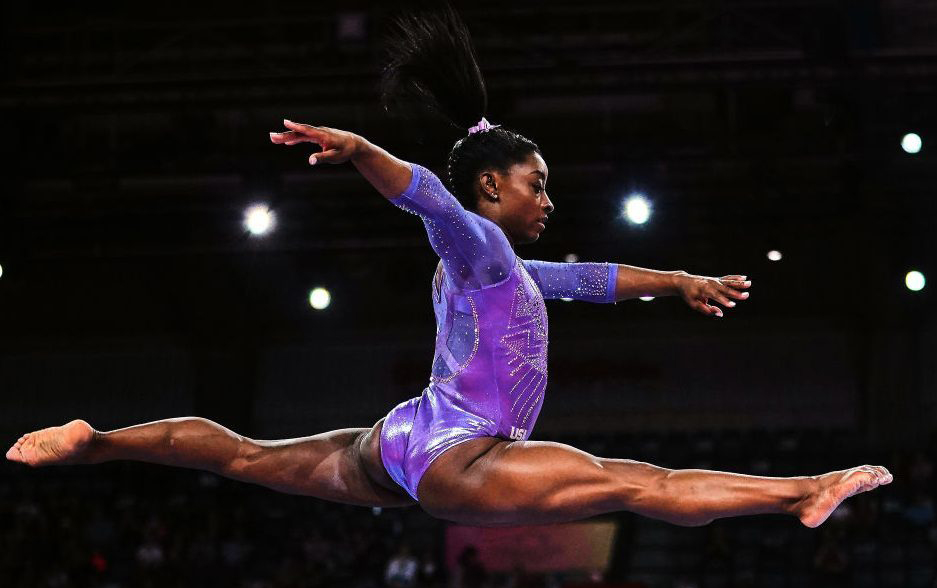




Facebook Comments